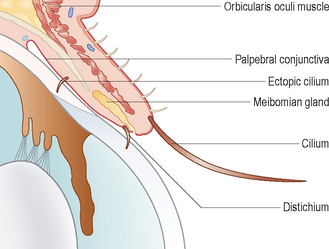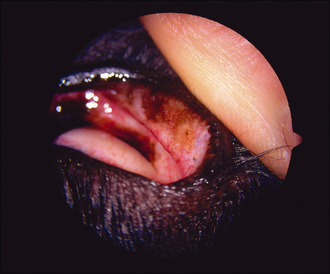7 Eyelash problems – distichiasis and ectopic cilia
PRESENTING SIGNS
Eyelash abnormalities are very common in dogs but are rarely encountered in cats. Distichia are extra eyelashes along the eyelid margin which originate from slightly abnormal meibomian glands. Ectopic cilia are lashes which grow through the palpebral conjunctiva towards the cornea (Figure 7.1). The typical presentation, if the distichia are clinically relevant, is of wet, itchy eyes. Thus the owner reports the dog’s eyes run constantly and that it rubs them frequently. Some redness is reported but unless corneal ulceration has occurred the eyes are not usually overtly painful. Ectopic cilia more commonly result in corneal ulcers than do distichia. Some breeds such as the Staffordshire bull terrier, English bulldog, boxer, miniature long haired dachshund and cocker spaniel commonly develop distichia, while ectopic cilia are seen in flat coated retrievers and Staffordshire bull terriers more commonly than other breeds. An inherited incidence is clearly present but the exact inheritance has not been evaluated. Typically young dogs are presented from 6 to 18 months.
CLINICAL EXAMINATION
Sometimes the presence of the distichia might be masked by small globules of mucus along the lid margin. Gently bathing the eyes should clear these. Careful examination with good illumination and magnification (+20D on the direct ophthalmoscope is adequate) is required, paying attention to all four eyelid margins. Placing a drop of fluorescein in the eye might highlight the lashes further. Identification of the distichia is not normally difficult – it is deciding whether they are the cause for the dog’s symptoms that is more challenging. Many cases are subclinical, incidental findings, and a thorough examination of the rest of the eyes is required to see if there is another explanation for the lacrimation and irritation. The lashes should be evaluated for position, thickness and number, along with their direction. Even multiple fine lashes might be insignificant if they are not in direct contact with the corneal tear film, whereas one thick, stubby lash directed towards the cornea can be very significant.
In addition to identifying the lashes, the fluorescein will obviously highlight any corneal ulceration. If this is present, its location should be checked against the position of the distichia. If none are parallel to the ulceration, then they are unlikely to have caused it. Everting the upper eyelid, and checking carefully for any ectopic cilia, is essential if any corneal ulceration is present (Figure 7.2). One or two ectopic cilia can be present, normally close to 12 o’clock on the upper lid, 4–6 mm from the eyelid margin. Their presence is almost always clinically significant. If ulceration is a feature, then a mild reflex uveitis might be noted, but normally there is no intraocular involvement and thus the rest of the ocular examination is unremarkable.





